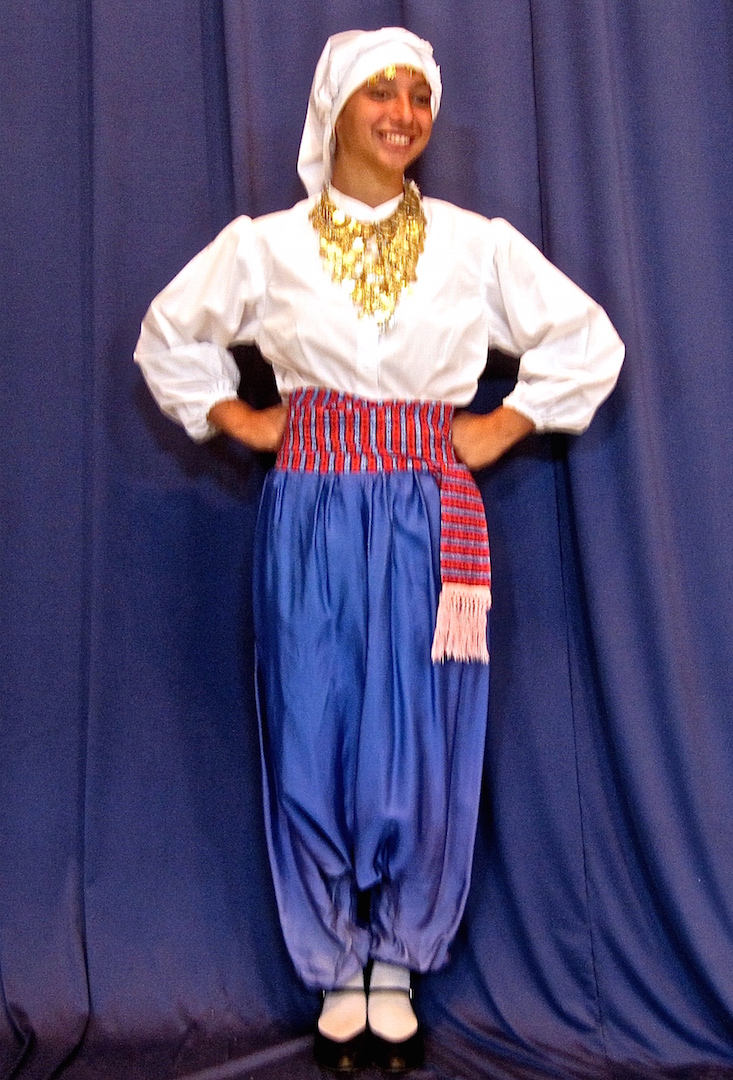
The Aegean Islands
The Aegean Islands are a group of islands in the north Aegean Sea. Some of the islands located in the North Aegean are Chios, Ikaria, Lesbos, Limnos, Samos, and Samothrace.
Popular dances from the Aegean Islands
Ballos (Chios), Bros Pis (Limnos), Detos (Chios), Foties (Lesbos) Ikariotikos (Ikaria), Koukia (Lesbos), Patma (Limnos), Plataniotikos (Samos), Platanisios (Samothrace), Pyrgousikos (Chios), Samiotikos/Vagia Stroste (Samos), Tripatos (Chios), Tsamourikos (Ikaria), and Yiar Yiar (Samothrace)
Costumes from the Aegean Islands
| This costume was called a “skoliano” (festival) dress in the dialect of Pyrgi, Chios. The sleeveless chemise is traditionally made from white cotton. The outer dress (the “samaraki”) has a pleated back. A distinctive feature of this costume are the scarves hung together over the chest since it was deemed shameful for women to show their breast. The headscarf (the “sariki”) was first worn when a woman turned 20 or earlier if she got married. It consists of a stiff cap and the “sariki” itself, which is wound around it. Brides added red pompoms on the left side of their heads. The headdress was held in place with long stickpins (the “karkavelones”) and the breast was adorned with the jewelry. |  |
 |
||
| This costume of Pyrgi, Chios featured baggy trousers rather than the typical “vraka” and was called the “rasozipouna.” The collar and sleeves are typically decorated with multicolored designs known as “ploumia.” A black woolen sash is worn around the waist and a red sash, called the “fengarato”, is worn over the black sash. A scarf, known as the “brilia”, is fastened around the neck. |  |
 |
||
| This costume from the islands of Limnos is the costume of the “kechayiades.” The “kechayiades” were typically farmers or cattle-raisers who worked to acquire their own property and cattle. Over the undergarment, a white “vraka” (the “sela”) and a waistcoat (the “mendenoyetheko”) are worn. A black sash is worn around the waist. The leggings, called the “hypodimata”, are traditionally made from locally produced kidskin. Pigskin shoes (the “stirvoulia”) are secured with leather straps called the “lagares.” The headdress is made of a white felt head cover (the “katsouli”) wrapped similar to a turban. |  |
 |
||
| This costume was worn by many of the women of Lesbos up until the first decades of the 20th century; however, it is not known when the costume first appeared. It is thought to have influences from the East, the islands of the Sea of Marmara, and Asia Minor. The pants, which were called “vraka” or “vraki”, are the main component of the everyday and festive costumes of Lesbos. In order to increase the appearance of the pants, women wore many pairs of pants. Wearing additional pants added a certain flow to the costume allowing it to move gracefully with the music’s beat and the dancer’s movements. Typically the “vrakia” were made from silk with vibrant colors and various patterns. The headscarf (the “tsemperi”) was usually monochrome or white. In the city of Mytilene and the northeastern part of the island the costume composed of the skirt (the “fstan” or “fstana”) was the most common. |  |
|||
